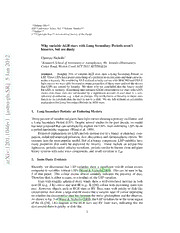
Why variable AGB stars with Long Secondary Periods aren't binaries, but are dusty PDF
Preview Why variable AGB stars with Long Secondary Periods aren't binaries, but are dusty
**VolumeTitle** ASPConferenceSeries,Vol.**VolumeNumber** **Author** (cid:13)c**CopyrightYear**AstronomicalSocietyofthePacific WhyvariableAGBstars withLong Secondary Periodsaren’t binaries, but aredusty 2 ChristineNicholls1 1 0 1ResearchSchoolofAstronomy&Astrophysics, Mt. StromloObservatory, 2 CotterRoad,WestonCreekACT2611AUSTRALIA n a Abstract. Roughly30%of variableAGBstarsshow a LongSecondaryPeriod, or J LSP.TheseLSPshaveposedsomethingofaprobleminrecentyearsandtheircausere- 5 mainsamystery.BycombiningVLT-derivedvelocitycurveswithMACHOandOGLE lightcurveswewereabletoexaminemanypropertiesofthesestarsandtestthetheory ] R that LSPs are caused by binarity. We show why we concludedthat the binarymodel S forLSPsisunlikely. Examiningmid-infraredSAGEobservationsforstarswithLSPs shows that these stars are surrounded by a significant amount of cool dust in a non- . h sphericaldistribution,e.g. adiskorclumps. Theunlikelinessofbinarityinthesestars p forcesus to concludethatthe dustis notin a disk. We are leftwithoutan acceptable - o explanationforLongSecondaryPeriodsinAGBstars. r t s a 1. LongSecondaryPeriods: anEnduringMystery [ 1 Thirtypercentofvariableredgiantshavelightcurvesshowingaprimaryoscillationand v a Long Secondary Period (LSP). Despite several studies in the past decade, no model 6 hasbeenproposedthatcansatisfactorilyexplaintheLSPs. StarsexhibitingLSPslieon 4 aperiod-luminosity sequence (Woodetal.1999). 0 Proposedexplanations forLSPsinclude motionduetoabinaryorplanetary com- 1 . panion,radialandnonradialpulsation,dustobscurationandchromospheric effects. We 1 examineherethemostpopular model,thatofabinarycompanion. LSPvariables have 0 2 many properties that could be explained by binarity. These include an eclipse-like 1 lightcurve, periodic radial velocity variations, periods similar toknownclose redgiant v: binarysystemswithsolarmasscomponents, andsmallvariationinTeff. i X 2. SomeDustyEvidence r a Recently, we discovered that LSP variables show a significant mid-IR colour excess compared tovariables without LSPs(Wood&Nicholls 2009). Thiscanbeseen infig. 3 of that paper. This colour excess almost certainly indicates the presence of dust. Thereforedustiseitheracause,oraproduct of,theLSPvariation. Stars with roughly spherical dusty winds show a well-correlated increase in both near-IR (e.g. J-K) colour and mid-IR (e.g. K-[24]) colour with increasing mass loss rate. However, objects such as RCB stars or RV Tauri stars with patchy or disk-like circumstellar dustshow alargemid-IRexcess butavariable near-IR colour depending onwhetherthecircumstellardustliesbetweenthestellarphotosphere andtheobserver. Asshowninfig. 3ofWood&Nicholls(2009),theLSPvariableslieinthesameregion of the (K-[24], J-K) diagram as the RCB stars and RV Tauri stars, indicating that the dustaroundthemispatchyordisk-like. 1 2 ChristineNicholls Dusty disks are usually associated with binaries. Therefore, this appears to be evidence infavourofabinarycauseforLongSecondaryPeriods. 3. SomeProblems However, the binary model has its problems. The LSP velocity curves have a charac- teristic shape which, for abinary system, suggests an eccentric orbit and a large angle ofperiastron, ω,withanon-uniform distribution (seefig. 4of Nichollsetal.2009). One expects ω to be uniformly distributed for binaries. Applying a K-S test, we findtheprobability thatourdistribution ofωisconsistentwiththeuniformdistribution is1.4×10−3. Inotherwords,theprobabilitythatLSPvariablesarebinariesisextremely small. Our stars also have low, relatively similar velocity amplitudes, something unex- pected in a sample of binaries. The median LSP velocity amplitude in our sample is 3.5kms−1, and deviation from this value is small. In a binary system, the velocity amplitude and period give an estimate of the mass of the companion. For a typical LSP variable with LSP = 500 days, velocity amplitude = 3.5kms−1, and assuming M = 1.5M , the orbital separation is ∼1.4 AU and the companion has a mass of tot ⊙ 0.09M . ⊙ This characteristic companion mass is problematic: there is an observed deficit of binary companions of ∼ 0.09M to main sequence stars, compared to both more ⊙ massive stellar companions and less massive planetary companions. This is known as the ‘Brown Dwarf Desert’. Indeed, using the results of Grether&Lineweaver (2006) wecalculateonly0.86%ofsolar-vicinity mainsequencestarsshouldhavecompanions between 0.06 and 0.12M . Given that ∼ 30% of AGB stars show LSPs, if LSP vari- ⊙ ables are binaries we would expect ∼ 30% of stars to have companions in this mass range. SomesuggestthatLSPsmaybecausedbyellipsoidal variation, wherearedgiant is distorted by a close companion. The light curves of ellipsoidal variables should complete two cycles for every velocity curve cycle, asthe light variation is dominated bythestar’sellipsoidal shape,whilethevelocitycurveisdominatedbyorbitalmotion. However we recently showed (Nichollsetal. 2010) that LSP variables do not show ellipsoidal variations. 4. DoesDustHoldtheAnswer? LSP variables show a significant mid-IR excess that indicates dust in a non-spherical distribution. Althoughthisnormallyindicatesadustydisk,theseareusuallyassociated with binaries, and we have presented convincing evidence against a binary model for LSPsabove. Atthis stage, wecan say that LSPvariables probably have asymmetrical dustejections, butcannotshedanyfurtherlightontheunderlying causeofLSPs. References Grether,D.,&Lineweaver,C.H.2006,ApJ,640,1051.arXiv:astro-ph/0412356 Nicholls,C.P.,Wood,P.R.,&Cioni,M.2010,MNRAS,405,1770.1002.3651 Nicholls,C.P.,Wood,P.R.,Cioni,M.,&Soszyn´ski,I.2009,MNRAS,399,2063.0907.2975 Wood, P. R., & et al. (MACHO Collaboration) 1999, in IAU Symp. 191: Asymptotic Giant BranchStars,editedbyT.LeBertre,A.Lebre,&C.Waelkens(SanFrancisco: Astro- nomicalSocietyofthePacific),151 Wood,P.R.,&Nicholls,C.P.2009,ApJ,707,573.0910.4418
